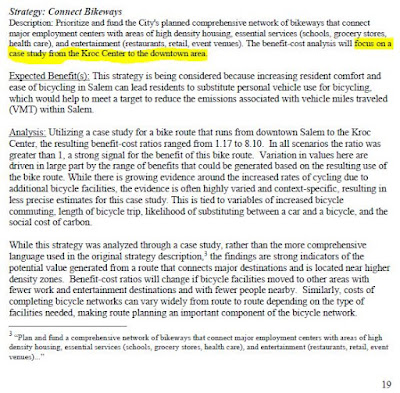A little buried perhaps on Council's agenda for Monday the 13th is some preparatory material for the formal Work Session on the 20th.
The one new item is the "Benefit-Cost Analysis of 10 Strategies for Salem's Climate Action Plan."
 |
| Analysis of 10 Strategies |
It is worth more attention and there will be more to say.
Here are four quick hits, one on overall approach, and three on the analysis.
First off, it just exemplifies the way the process has been structured to avoid engaging the central goals, that of reducing our emissions by 50% in 2035 and the other goal of being carbon neutral by 2050.
Instead, this is all about how expensive or how difficult a very small subset of 10 actions will be. It shifts the focus from actual reductions to efficiency.
This kind of analysis belonged earlier in the process, and is misplaced now at the end of the process. It should have been a preliminary SWAG done at a very early stage that then guided further refinement in an iterative process designed to get us to that 50% reduction for 2035.
Within the limitations of this approach, then, the number one strategy is not very surprising.
 |
| Right-priced parking at the top |
Over and over we keep circling around and avoiding parking. It's a third rail. That needs to stop. The evidence against free parking is overwhelming. It's time to end it.
 |
| The call for "further research" vitiates |
Unfortunately, the analysis vitiates the conclusion by including it at the top of a list of topics for "further research." We have so much research on "the high cost of free parking"! There's a whole freakin' book on it - and a sequel!
 |
| Walkable City Rules |
In his Walkable City Rules, Jeff Speck distills this into "a three-legged stool":
- Eliminating parking minimums
- Pricing parking based on its market value
- Creating Parking Benefits Districts to spend parking benefits locally
Ending our commitment to free parking is something we can do right now.
 |
| Using a case study from the Kroc |
When they turned to the network of bike lanes and bikeways, their analytical method seemed very odd. It merits more thought. Maybe a second glance with make more sense of it.
 |
| (September 2019 |
But they chose to focus on "a case study from the Kroc Center to the downtown area." The Kroc Center at its inception was located in an industrial area that will be difficult to retrofit for good bike connectivity, since it is isolated by the high-speed Parkway and highway connection as well as by two railroad lines. It does not seem like a very representative or promising unit for a "case study," and I am not very confident in any "benefit-cost" analysis arising out of that.
Finally, they did not seem very optimistic about dedicated transit lanes, and it will be interesting to see if Cherriots has any comment on this. They did say that this analysis was one in which the results varied greatly depending on modeling assumptions, and therefore the certainty was lower. This may be one part the study that really does merit further research.
In the end, this "benefit-cost" analysis is ostensibly positioned as something to help Council and policy-makers, but it may participate more as a sophisticated kind of "discourse of climate delay," focusing on difficulty rather than necessity.
 |
| Several climate delay discourses |


No comments:
Post a Comment